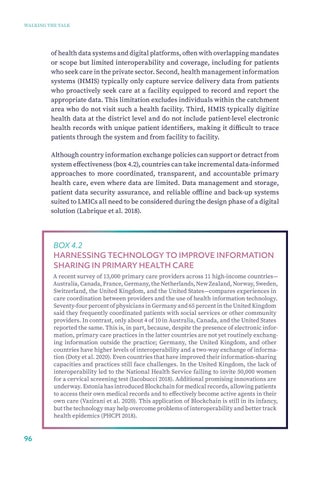WALKING THE TALK
of health data systems and digital platforms, often with overlapping mandates or scope but limited interoperability and coverage, including for patients who seek care in the private sector. Second, health management information systems (HMIS) typically only capture service delivery data from patients who proactively seek care at a facility equipped to record and report the appropriate data. This limitation excludes individuals within the catchment area who do not visit such a health facility. Third, HMIS typically digitize health data at the district level and do not include patient-level electronic health records with unique patient identifiers, making it difficult to trace patients through the system and from facility to facility. Although country information exchange policies can support or detract from system effectiveness (box 4.2), countries can take incremental data-informed approaches to more coordinated, transparent, and accountable primary health care, even where data are limited. Data management and storage, patient data security assurance, and reliable offline and back-up systems suited to LMICs all need to be considered during the design phase of a digital solution (Labrique et al. 2018).
BOX 4.2 HARNESSING TECHNOLOGY TO IMPROVE INFORMATION SHARING IN PRIMARY HEALTH CARE A recent survey of 13,000 primary care providers across 11 high-income countries— Australia, Canada, France, Germany, the Netherlands, New Zealand, Norway, Sweden, Switzerland, the United Kingdom, and the United States—compares experiences in care coordination between providers and the use of health information technology. Seventy-four percent of physicians in Germany and 65 percent in the United Kingdom said they frequently coordinated patients with social services or other community providers. In contrast, only about 4 of 10 in Australia, Canada, and the United States reported the same. This is, in part, because, despite the presence of electronic information, primary care practices in the latter countries are not yet routinely exchanging information outside the practice; Germany, the United Kingdom, and other countries have higher levels of interoperability and a two-way exchange of information (Doty et al. 2020). Even countries that have improved their information-sharing capacities and practices still face challenges. In the United Kingdom, the lack of interoperability led to the National Health Service failing to invite 50,000 women for a cervical screening test (Iacobucci 2018). Additional promising innovations are underway. Estonia has introduced Blockchain for medical records, allowing patients to access their own medical records and to effectively become active agents in their own care (Vazirani et al. 2020). This application of Blockchain is still in its infancy, but the technology may help overcome problems of interoperability and better track health epidemics (PHCPI 2018).
96


